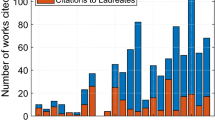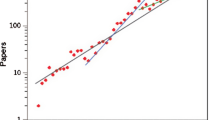Abstract
A detailed analysis of the research carried out in Mexico in the physics specialty of particles and fields (MPPF) reveals the way the current production and citation patterns evolved over a period of 60 years. The basis for the analysis were the publications and citations registered in the Stanford Public Information REtrieval System—High Energy Physics (SPIRES) from 1970 to 2007. The historical coverage afforded by the Science Citation Index provided supplementary data from 1948 to 1979. Papers were classified into five research types: theoretical, phenomenological, experimental, cosmological, and other, while citations were identified as coming from: published or unpublished sources. Results show that the development of MPPF emerged from traditional theoretical and phenomenological research and that the most notable changes taking place in production and impact are associated with the community’s involvement in more productive and more internationally visible research practices, characteristic of large international collaborations, leaders in experimental physics and in the authorship of review papers.




Similar content being viewed by others
References
Abachi, S., et al. (1995). Observation of the top quark. Physical Review Letters, 74(14), 2626–2631.
Autio, E., Bianchi-Streit, M., & Ari-Pekka, H. (2003). Technology transfer and technological learning through CERN’s procurement activity CERN-2003-005 (Education and Technology Transfer Division). Retrieved September 14, 2008 from http://wwwesbrise/OH_030409pdf#search=‘autio%20internationalization.
Aymar, R. (2009). Scholarly communications in high-energy physics: Past, present and future innovations. European Review, 17(1), 33–51.
Brody, T. A., Flores, J., French, J. B., Mello, P. A., Pandey, A., & Wong, S. A. (1981). Random-matrix physics-spectrum and strength fluctuations. Reviews of Modern Physics, 53(3), 385–479.
Brown, C. (2004). The coming of age of E-prints in the literature of physics 19. Retrieved July 2004 from http://wwwlibraryucsbedu/istl/01-summer/refereedhtml.
Brum, J. A., & Meneghini, R. O. (2002). Laboratorio Nacional de Luz Sincrotrón. Sao Paulo en Perspectiva, 16(4), 48–56.
Casas, R., Gortari, E., & De Santos, M. J. (2000). The building of knowledge spaces in Mexico: A regional approach to networking. Research Policy, 29, 225–241.
Collazo-Reyes, F. (2002). Dinámica de la Literatura Citada en la Física Mexicana en el Período de Mayor Crecimiento. Revista Española de Documentación Científica, 25(4), 395–407.
Collazo-Reyes, F., & Luna-Morales, M. E. (2002). Física Mexicana de Partículas Elementales: Organización, Producción Científica y Crecimiento. Interciencia, 27(7), 347–353.
Collazo-Reyes, F., Luna-Morales, M. E., & Russell, J. M. (2004). Publication and citation patterns of the Mexican contribution to a big science discipline: Elementary particle physics. Scientometrics, 60(2), 131–143.
Cronin, B. (2004). Scholarly communications and epistemic cultures. New Review of Academic Librarianship, 19(1), 1–24.
Eidelman, S., et al. (2004). Review of particle physics: Particle data group. Physics Letters B, 592(1–4), 1–1110.
Gentil-Beccot, A., Mele, S., & Brooks, T. C. (2009a). Citing and reading behaviours in high-energy physics. How a community stopped worrying about journals and learned to love repositories. ArXiv: 0906.5418. SLAC-PUB-13693.
Gentil-Beccot, A., Mele, S., Holtkamp, A., O′Connell, H., & Brooks, T. C. (2009b). Information resources in high-energy physics: Surveying the present landscape and charting the future course. Journal of the American Society for Information Science and Technology, 60(1), 150–160.
Ginsparg, P. (2000). Creating a global knowledge network: Don’t just clone the paper methodology. In Freedom of information conference, 6–7 July 2000. New York Academy of Medicine.
Harnad, S. (2003). Eprints: Electronic preprint and postprint. Encyclopedia of library and information science. England: Marcel Dekker. Retrieved September 2008 from http://www.cogsci.soton.ac.uk/harnad/Temp/eprint.htm.
Herrera-Corral, G. (2005). La Materia en Condiciones Extremas: el proyecto ALICE. Ciencia, 56(1), 36–43.
Hurd, J. M. (1996). Models of scientific communications systems. In S. Crawford, J. M. Hurd, & C. Weller (Eds.), From print to electronic: The transformation of scientific communication (pp. 9–35). New Jersey: American Society for Information Science.
Iribarne, A., & Gadille, M. (1999). The National Institute of Nuclear and Particle Physics: A framework of institutional regulation governing the relationships between basic research, academia and industry. Retrieved July 2008 from http://usersfmguvanl/lleydesdorff/th2/tochtm.
Jones, B. F., Wuchty, S., & Uzzi, B. (2008). Multi-university research teams: Shifting, impact, geography, and stratification in science. Science, 322(21), 1259–1262.
Knorr-Cetina, K. (1999). Epistemic cultures: How the sciences make knowledge. Cambridge: Cambridge University Press.
Konnigsberg-Levy, J. (2005). Cacería de Quarks. Ciencia, 56(1), 20–35.
Kostoff, R. N., & Del Río, J. A. (2001). Physics research impact assessment. Physics World, 14(6), 47–52.
Langer, J. (2000). Physicists in the new era of electronic publishing. Physics Today, (August), 35–38.
Lehman, S., Lautrup, B., & Jackson, D. (2003). Citation networks in high energy physics. Physical Review E, 68, 026113.
Lequeux, J., Peimbert, M., Rayo, J. F., Serrano, A., & Torres-Peimbert, S. (1979). Chemical-composition and evolution of irregular and blue compact galaxies. Astronomy and Astrophysics, 80(2), 155–166.
Lincoln, D. (2004). Understanding the universe: From quarks to the cosmos. Singapore: World Scientific.
Luna-Morales, M. E., & Collazo-Reyes, F. (2002). El síndrome Big Science y su Influencia en el Proceso de Maduración de la Física Mexicana de Partículas Elementales. Revista Española de Documentación Científica, 25(4), 409–420.
Luna-Morales, M. E., Collazo-Reyes, F., Russell, J. M., & Pérez Angón, M. A. (2009). Early patterns of scientific production by mexican researchers in mainstream journals: 1900–1950. Journal of the American Society for Information Science and Technology, 60(7), 1337–1348.
Luna-Morales, M. E., & Russell, J. M. (2009). El Uso de Nuevas Tecnologías de Información por Investigadores Mexicanos del Área de Física de Partículas Elementales. México: UNAM, CUIB.
Plebanski, J. F. (1975). Some solutions of complex einstein equations. Journal of Mathematical Physics, 16(12), 2395–2402.
Russell, J. M. (2001). Scientific communication at the beginning of the 21st century. International Social Science Journal, (168), 271–282.
Sierra-Flores, M. M., Guzmán, M. V., Raga, A. C., & Pérez, I. (2009). The productivity of Mexican astronomers in the field of outflows from young stars. Scientometrics, 81(3), 765–777.
Subotzky, G. (2005). Complementing the marketization of higher education: New modes of knowledge production in community-higher education partnerships. Retrieved July 2008 from http://www.chet.org.za/oldsite/debates/SanLameer/Subotzky.html.
Wagner, C. S. (2004). International collaboration in science: A new dynamic for knowledge creation. Thesis, Amsterdam: Amsterdam School of Communications. Retrieved October 2008 from http://users.fmg.uva.nl/lleydesdorff/cwagner/Thesis/.
Yao, W. M., Amsler, C., Asner, D., Barnett, R. M., Beringer, J., Burchat, P. R., et al. (2006). Review of particle physics. Journal of Physics G: Nuclear and Particle Physics, 33(1), 1–1000.
Ziman, J. (1994). Prometheus bound: Science in a dynamic steady state. Cambridge: Cambridge University Press.
Author information
Authors and Affiliations
Corresponding author
Rights and permissions
About this article
Cite this article
Collazo-Reyes, F., Luna-Morales, M.E., Russell, J.M. et al. Enriching knowledge production patterns of Mexican physics in particles and fields. Scientometrics 85, 791–802 (2010). https://doi.org/10.1007/s11192-010-0229-1
Received:
Published:
Issue Date:
DOI: https://doi.org/10.1007/s11192-010-0229-1




